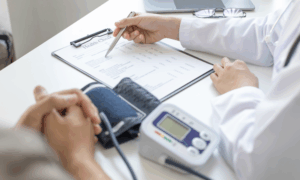| STT (No) |
DETAILED LIST OF GENERAL CHECKUP PACKAGES (Detailed General Health Check-up Package) |
|
|||||
|---|---|---|---|---|---|---|---|
| A. NURSING SECTION | |||||||
| 1 | Weight, Height, Body mass index | X | X | ||||
| 2 | Vital signs: pulse, blood pressure, temperature, respiratory rate | X | X | ||||
| 3 | Eye: vision check | X | X | ||||
| B. CLINICAL EXAMINATION | |||||||
| 4 | Comprehensive examination with a general internal medicine specialist: ask about medical history, medical history, clinical examination, consult on test results, prescribe treatment, consult on vaccination, plan health monitoring by a general internal medicine specialist, USMLE Step 3 certification direct examination. (General Internal Medicine Consultation: Thorough medical assessment including history taking, physical examination, test result review, immunization consulting and treatment — performed by an Internal Medicine specialist with USMLE Step 3 (US) certification.) | X | X | ||||
| 5 | Ear, nose, and throat specialist examination: Examination and consultation of ENT issues by an ENT specialist (ENT check: examine and consult ENT issues with an ENT Specialist) | X | X | ||||
| 6 | Gynecological examination: Breast examination and consultation on breast diseases; examination and consultation on common gynecological problems (Gynecology examination: perform manual breast examination and consult breast issues, consult common gynecological issues) | X | |||||
| C. BLOOD TEST SECTION | |||||||
| 7 | Full blood count: reviews of infection, anemia, platelet count-related disorder, leukemia, etc. | X | X | ||||
| 8 | hs-CRP High-Sensitivity C-Reactive Protein: a highly sensitive blood test that detects low-grade chronic inflammation even when cholesterol levels are normal, used to assess the risk of cardiovascular disease | X | X | ||||
| 9 | Fasting glucose: diabetes screening | X | X | ||||
| 10 | HbA1C: Helps diagnose diabetes or prediabetes (HbA1c (Glycated Hemoglobin): helps diagnose diabetes mellitus and prediabetes) | X | X | ||||
| 11 | ApoB/ApoA1 Ratio: This is a measure of cardiovascular risk, reflecting the balance between atherosclerotic and anti-atherosclerotic particles in the blood. An increased ratio indicates a higher risk of heart attack or stroke, due to an increase in atherogenic (apoB-rich) particles or a decrease in protective (apoA1-rich) particles. This is considered a better predictor of cardiovascular disease than other common measures such as the total cholesterol/HDL-C ratio. | X | X | ||||
| 12 | Cholesterol total: helps evaluate the risk of atherosclerosis, cardiovascular risk (Cholesterol total: evaluate the risk of atherosclerosis) | X | X | ||||
| 13 | Triglyceride blood fat: helps evaluate the risk of atherosclerosis, cardiovascular risk (Triglyceride: evaluate the risk of atherosclerosis) | X | X | ||||
| 14 | LDL-c blood lipids: help assess the risk of atherosclerosis, cardiovascular risk (LDL-c: evaluate the risk of atherosclerosis) | X | X | ||||
| 15 | HDL-c blood lipids: help assess the risk of atherosclerosis, cardiovascular risk (HDL-c: evaluate the risk of atherosclerosis) | X | X | ||||
| 16 | Kidney function: evaluate the risk of kidney dysfunction | X | X | ||||
| 17 | Blood Urea Nitrogen: an additional test to assess kidney function by measuring the amount of urea nitrogen in the blood. | X | X | ||||
| 18 | Liver enzymes: investigate different causes of liver injury | X | X | ||||
| 19 | Liver enzymes: investigate different causes of liver injury | X | X | ||||
| 20 | GGT: investigates liver cell damage due to various causes (Liver enzymes: investigate different causes of liver injury) | X | X | ||||
| 21 | Total Bilirubin: A component of the comprehensive liver function test used to assess overall liver health. | X | X | ||||
| 22 | Direct bilirubin: Helps detect and monitor the progression of other liver diseases such as hepatitis, cirrhosis, gallstones, and cholangitis. | X | X | ||||
| 23 | Indirect Bilirubin: Used to screen for blood-related disorders such as hereditary anemia and hemolytic anemia. | X | X | ||||
| 24 | Alkaline Phosphatase (ALP): used to screen for and monitor treatment of liver diseases or bone disorders | X | X | ||||
| 25 | Albumin: used to screen for and help diagnose liver or kidney disorders, and to assess nutritional status. | X | X | ||||
| 26 | PT: assesses the liver's ability to synthesize clotting factors and evaluates blood coagulation function. | X | X | ||||
| 27 | Uric Acid: used to screen for protein metabolism disorders and gout. | X | X | ||||
| 28 | Hepatitis A screening: used to diagnose the cause of acute hepatitis, determine the need for vaccination against the hepatitis A virus. | X | X | ||||
| 29 | Hepatitis B screening (HBsAg): checks to see if you are infected with the hepatitis B virus. If positive, you may have acute or chronic hepatitis B. (This test checks if you are currently infected with the hepatitis B virus. A positive result may indicate acute or chronic hepatitis B.) | X | X | ||||
| 30 | Hepatitis B screening (HBsAb): This test checks for antibodies against the hepatitis B virus. If positive, you are likely immune to hepatitis B due to vaccination or past infection. (This test detects antibodies against the hepatitis B virus. A positive result means you are likely immune to hepatitis B due to vaccination or past infection.) | X | X | ||||
| 31 | Hepatitis B screening (anti-HBc total) anti-HBc total: test for antibodies against the hepatitis B virus. If positive, you have been exposed to the hepatitis B virus – may be current, resolved, or chronic. (A test for antibodies against the hepatitis B virus. If positive, it indicates previous exposure to the virus, the infection may be current, resolved, or chronic) | X | X | ||||
| 32 | Hepatitis C screening (anti-HCV): This test detects antibodies to the hepatitis C virus. If positive, you may have had or are currently infected with the hepatitis C virus. Further testing is needed to confirm. (This test detects antibodies to the hepatitis C virus. A positive result suggests past or current hepatitis C infection, requiring further tests to confirm.) | X | X | ||||
| 33 | Thyroid function TSH (Thyroid-Stimulating Hormone): Assesses thyroid function and helps detect disorders such as hyperthyroidism or hypothyroidism. TSH (Thyroid Stimulating Hormone): Assesses thyroid function and helps detect disorders such as hyperthyroidism or hypothyroidism. | X | X | ||||
| 34 | Thyroid function test – Total T3: assesses thyroid function, aids in the diagnosis of thyroid disorders, and monitors the effectiveness of thyroid disease treatment | X | X | ||||
| 35 | Thyroid function test – Free T4: assesses thyroid function, aids in the diagnosis of thyroid disorders, and monitors the effectiveness of thyroid disease treatment | X | X | ||||
| 36 | Electrolyte – Sodium (Na): Abnormal sodium levels may indicate serious health conditions such as kidney disease, hypertension, or cardiac rhythm disturbances. | X | X | ||||
| 37 | Electrolyte – Chloride (Cl): Abnormal chloride levels may indicate serious health conditions such as kidney disease, hypertension, or cardiac rhythm disturbances. | X | X | ||||
| 38 | Electrolyte – Potassium (K): Abnormal potassium levels may indicate serious health conditions such as kidney disease, hypertension, or cardiac rhythm disturbances. | X | X | ||||
| 39 | Calcium: Measures the amount of calcium in the blood. Diagnoses or detects conditions such as kidney disease, parathyroid disorders, thyroid disease, kidney stones, malabsorption, cancer, and malnutrition | X | X | ||||
| 40 | Vitamin D: To screen and monitor bone disorders. Helps guide supplementation for overweight-obese people, people with little exposure to sunlight, people with chronic or autoimmune diseases, etc. | X | X | ||||
| 41 | Phosphorus: Evaluates the level of phosphorus in the body — an essential mineral for building strong bones and teeth, supporting energy production, and maintaining normal cellular function. | X | X | ||||
| 42 | AFP (Alpha-Fetoprotein, Tumor Marker): used to diagnose and monitor liver conditions such as hepatocellular carcinoma, liver cirrhosis, and hepatitis. | X | X | ||||
| 43 | CEA (Carcinoma Embryonic Antigen marker) quantification: Related to some types of cancer, especially colorectal cancer. CEA supports initial diagnosis, monitors treatment effectiveness and detects early cancer recurrence. CEA results need to be combined with other diagnostic methods for the most accurate diagnosis. | X | X | ||||
| 44 | CA-125 (Cancer Antigen-125) Quantification: Monitor ovarian cancer treatment or detect cancer recurrence. Helps detect ovarian cancer early in people identified as high risk. | X | |||||
| 45 | CA 19-9 (Carbohydrate Antigen 19-9) test: Measures the level of a cancer marker in the blood, often linked to pancreatic, bile duct, or stomach cancer. High levels require additional tests for evaluation. | X | X | ||||
| 46 | Cyfra 21-1 measurement: Measures a cancer marker, mainly associated with lung cancer or other cancers. Elevated levels may suggest cancer risk, needing further investigation. | X | X | ||||
| 47 | Free PSA (Free Prostate-Specific Antigen): Measures free PSA levels in the blood to assess prostate cancer risk. A free PSA/total PSA ratio < 0.15 (15%) suggests a higher risk of prostate cancer. Additional tests (biopsy, MRI) are needed to confirm the diagnosis. (Measures free PSA levels in the blood to assess prostate cancer risk. A fPSA/tPSA ratio < 0.15 (15%) suggests a higher risk of prostate cancer. Further tests (biopsy, MRI) are needed to confirm the diagnosis.) | X | |||||
| 48 | Total PSA (Total prostate-Specific Antigen): Prostate cancer screening and evaluation (PSA (Prostate-Specific Antigen): used to evaluate and screen for prostate cancer) | X | |||||
| 49 | Testosterone: Helps detect abnormal levels of Testosterone, assess men's health. Diagnose the cause of erectile dysfunction or assess reproductive health. | X | |||||
| 50 | Estradiol: Measures and monitors estrogen levels. Helps detect abnormal or imbalanced hormone levels. Monitors infertility treatment or menopausal symptoms | X | |||||
| D. URINE TEST | |||||||
| 51 | Urinalysis: Investigate the presence of glucose, blood, protein, infection in the urine sample | X | X | ||||
| 52 | Urine sediment examination: detects and analyzes particles or “sediments” such as red blood cells, white blood cells, bacteria, crystals, or casts, which may indicate various kidney or urinary tract disorders. | X | X | ||||
| 53 | uACR (Urine Albumin-Cratinine Ratio): This helps assess kidney function, as healthy kidneys retain protein and only pass waste. A high uACR indicates kidney damage and may be an early sign of chronic kidney disease (CKD), which requires monitoring and treatment. | X | X | ||||
| E. STOOL TESTING | |||||||
| 54 | Fecal Occult Blood Test (Hemoccult): Detects the presence of hidden (microscopic) blood in stool, used for early screening of colorectal cancer. | X | X | ||||
| 55 | Direct Stool Microscopy: Detects the presence of red and white blood cells, as well as common intestinal parasites such as roundworms, whipworms, liver flukes, and protozoa like Cyclospora. | X | X | ||||
| F. BREATH TEST | |||||||
| 56 | Helicobacter pylori Breath Test – UBT C13: A non-invasive, safe, and accurate test for diagnosing Helicobacter pylori infection in the stomach. | X | X | ||||
| G. IMAGING DIAGNOSTIC SECTION | |||||||
| 57 | Digital Chest X-ray: evaluates pulmonary abnormalities such as pneumonia, pulmonary tuberculosis, bronchitis, and suspected lung masses or tumors. | X | X | ||||
| 58 | Electrocardiogram (ECG): abnormal findings commonly seen in high blood pressure, heart disease, arrhythmias, etc. | X | X | ||||
| 59 | Thyroid ultrasound (Thyroid US): examination of thyroid disease and cancer (Thyroid disease and thyroid cancer) | X | X | ||||
| 60 | Breast US: breast disease and breast cancer | X | |||||
| 61 | Transvaginal Pelvic Ultrasound: Examines the uterus and ovaries using a vaginal probe, providing detailed detection of gynecological issues such as tumors, inflammation, or ectopic pregnancy. | X | |||||
| 62 | Abdominal ultrasound (Abdominal US): examines organs: liver, gallbladder, pancreas, kidneys, bladder, uterus, ovaries, etc. (Organs involved: liver, gallbladder, pancreas, kidneys, bladder, uterus, ovaries, etc.) | X | X | ||||
| 63 | Echocardiography (Heart Ultrasound): Evaluates the function of the heart muscle and valves, helping to detect heart diseases and valvular disorders. | X | X | ||||
| 64 | Carotid Artery Ultrasound: Assesses the condition and function of the carotid arteries to detect early risks of stroke caused by carotid atherosclerosis. | X | X | ||||
| 65 | Lower Limb Venous Ultrasound: assesses the risk of varicose veins and deep vein thrombosis (DVT) in the lower limbs. | X | X | ||||
| H. GYNECOLOGICAL SECTION | |||||||
| 66 | Gynecology examination: Perform manual breast examination and consult breast issues; Consult common gynecological issues | X | |||||
| 67 | Pap Liquid: Cervical cancer screening | X | |||||
| 68 | HPV 40 Genotypes: Screens for the presence of human papillomavirus (HPV), which can cause genital warts, abnormal cervical cell growth, and cervical cancer. | X | |||||
| 69 | Vaginal wet mount: Check for infection, yeast infection, etc. (Sexually inactive females: apply this test instead of PAP smear) | X | |||||
| I. ENDOSCOPIC SECTION | |||||||
| 70 | ENT Endoscopy: Examines the nasopharynx and hypopharynx to detect early lesions such as nasopharyngeal, pharyngeal, or laryngeal cancers. | X | X | ||||
| COST OF EXAMINATION PACKAGE | Contact | Contact | |||||
- Make an appointment
- Notes before general examination
- Charis care examination package
- Charis Standard Health Checkup Package
- Charis Enhanced Health Checkup Package
- Charis Advanced Examination Package
- Charis Comprehensive Health Checkup Package
- Charis Premium Health Checkup Package
- Charis Signature Health Checkup Package
- Charis Platinum Health Checkup Package
- Charis Executive Health Checkup Package
- Charis Infinite Health Checkup Package
- Corporate Health Checkup
- Team of doctors
- Insurance payment
- About us
- Contact
MEDICAL SERVICES
Specialized examination services
Other medical services
- Intensive health care
- Gastrointestinal endoscopy
- Cancer screening
- ENT endoscopy
- Vaccination
- Testing
- Diagnostic imaging
- First aid
GENERAL HEALTH CHECKUP
Health check-up package for adults
- Charis Care Examination Package
- Charis Standard Health Checkup Package
- Charis Enhanced Health Checkup Package
- Charis Advanced Examination Package
- Charis Comprehensive Health Checkup Package
- Charis Premium Health Checkup Package
- Charis Signature Health Checkup Package
- Charis Platinum Health Checkup Package
- Charis Executive Health Checkup Package
- Charis Infinite Health Checkup Package







